Disclosure: Some posts contain affiliate links, which earn us a commission if you make a purchase through them. Positive Fishing © participates in various affiliate networks including the Amazon Services LLC Associates Program.
Fishing with beads has multiple uses, and colored beads have been used for many years for various fishing purposes.
While using beads to replicate fish eggs for fly fishing is well known, many anglers (sea and coarse fishermen) also use beads for different reasons – generally as part of rigs to prevent knot friction and trap swivels. In addition, lure fishermen often use beads as part of their lure or spinner to create colored attraction to the bait.
So, let us go through all the uses of beads in fishing and find their purposes.
In this article, I will cover the following:
- Purpose Of Using Beads When Fishing
- Fly Fishing – As replicating a fish egg
- Sea Fishing – Attaching to the line or as an attractor
- Lure Fishing
- Beads For Fly Fishing
- When Should I Use a Bead When Fly Fishing?
- When Is The Best Time To Use Beads?
- How To Setup A Bead Rig?
- How Do I Fish with a Bead?
- What Are The Best Bead Colors?
- Where Do I Find the Right Beads?
- Beads Attached To Flies
- Beads Used For Sea Fishing
- Beads For Spin Fishing and Lure Fishing
1. Beads For Fly Fishing
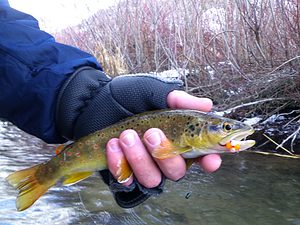
The major reason that fly anglers use beads is to recreate representations of fish eggs. During spawns, eggs often become food for other fish. While some fly anglers are willing to use live eggs, the more traditionalist anglers choose to use an egg representation, otherwise known as a bead.
The second reason is that a color bead gives off an additional attractant when incorporated into fly patterns. These are known as bead heads, which are part of your fly pattern; as the sun shines through the water column, these bead heads (usually gold in color) create flashing to fly patterns, which encourages the trout to take the fly.
When Should I Use a Bead When Fly Fishing?
Whether it’s the salmon or steelhead spawn, trout love to feed on these eggs due to their ease of access and nutritional value, so it’s best to use a bead when your target fish are spawning for the best results. It should be noted that trout also eat the eggs of other trout!
Salmon will spawn from the spring through summer and into the late fall. Steelhead will spawn late in the season at the beginning of winter. Rainbow trout spawn during the spring months and can vary based on which part of the world you are located. Brown trout will spawn during fall.
When Is The Best Time To Use Beads?
When fly fishing for salmon or trout, the best months for using beads are July and August. This is prime bead fishing season due to the sockeye run followed closely by the trout.
As the salmon reach their spawning grounds, the trout begin to mix with them. Once the salmon eggs are laid, the trout will be ready for free food! This is the perfect time to replicate the eggs using red or orange beads.
Targeting Trout During Salmon Spawn
If you’re targeting trout or char and fishing waters with salmon, you should always know when the spawn time will happen. Trout and char go into a feeding frenzy when salmon begin to spawn.
Since salmon often spawn in gravel, these eggs are easily accessible. The current takes any egg that doesn’t fall and sticks itself deep in the rocks. Trout prefers to sit downstream of the spawning grounds and feast on these eggs as they drift towards them. As long as you can match the size of the bead, you’ll be able to land all sorts of fish.
Targeting Trout During Steelhead and Trout Spawn
When the steelhead and trout begin to spawn, beads should be brought out of your box. Both steelhead and trout will eat the eggs. If you find yourself in the right place at the right time, you’ll catch all the fish you need.
Check with your local fly shops when beads will be most effective! You don’t want to miss some of the most prolific fishing of the year.
How To Setup A Bead Rig?
Many anglers appreciate using a bead rig because they’re one of the least intrusive fishing methods. Fish rarely swallow the hook, and it almost ends up in their mouth.
Strike Indicator
If you’re the type who likes strike indicators, you can use them with a bead rig. It’s not required, but it can help if you fish in faster-moving water. They’ll make detecting a strike far easier than fishing without an indicator!
Leader
With your leader, you have a couple of options. They’re usually not very long when you’re fishing a bead! Use a 4 to 8-foot leader between 8 and 12lb test. A quality monofilament line is the right line material for most leaders.
If you like tapered leaders, you can also use these without a tippet. Another easy option is a 7 to 10-foot tapered leader with a strike indicator. Make sure the indicator is easily adjustable.
Tippet
For your tippet, you will want around 2 feet of fluorocarbon line. It’s harder for the fish to see and is a bit stronger than monofilament. Make sure your tippet is at least an 8-pound test. You don’t want to miss any of these fish due to a weak tippet. With the perfect leader and tippet combination, you’ll find that there is less drag.
The Bead
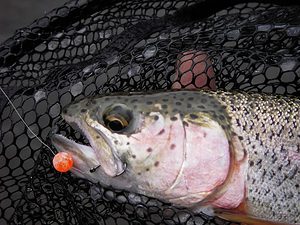
When you’re ready to attach the bead, the only step after this will be to tie on your hook. Attaching the bead is fairly easy. Slide the bead onto the leader/tippet and get ready to “peg” it in place. You’ll notice that the opening for the bead is far larger than the tippet. You can use a legitimate bead peg or a toothpick to peg it. Either will work! Stick the peg into the opening on the bead and snap off the peg so it doesn’t stick out on either side.
You can also use a bead knot. All you have to do is place the leader through the opening on the bead two times, and it’ll wedge it in place. Plus, you can adjust where it sits fairly easily.
You’ll want the bead to be attached within 2 to 4 inches of the hook for the best results.
Choosing The Hook When Using Beads
Since beads don’t have hooks like a traditional fly, you’ll have to attach your own choice of hook. A nymph hook between 4 and 8 is great. Once you attach the hook, adjust the bead so it sits a couple of inches above it, and you’ll be ready to go.
How Do I Fish With a Bead?
When you’ve timed things right and noticed that the spawn is occurring, it’s time to bring out the beads. Once you learn how to fish with them properly, you’ll find that landing fish isn’t nearly as complicated as you thought.
Read the Water
Now, bead fishing can be productive in all different types of water, but a “fast-walk” pace of water will be the easiest to fish. You can achieve realistic drifts and leave the bait in the strike zone for the optimum time. This type of water will be found in wider river sections or below a pool.
Casting before pools is another decent place to toss your bead. Let it bounce around in the rocks and eventually drift into the pool. Fish will likely be stacked up at the beginning of the pool to snatch up any beads that make their way in front of them.
Finally, during the spawn, sight fishing is a great technique. If you see a fish darting around the bottom of the water column, it’s your time to shine. A fish staying in one place isn’t likely actively feeding, but that doesn’t mean it’s impossible to land them. A fish showing movement back and forth is definitely interested in eating. These are great fish to target! Throw your bead upstream and let it drift in front of it.
Think Nymph Fishing
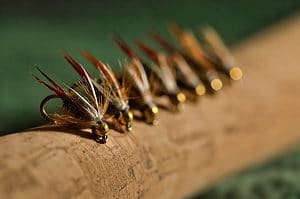
If you’ve never fished with beads before, you’ll find that it’s not that different from nymph fishing. Once you understand this, the position to cast your flies and find the sweet spot becomes easier. Cast 20 or 30 feet about 45 degrees upstream from you. This will give you enough time to mend and present the fly properly.
Food isn’t scarce when salmon are spawning. The eggs are everywhere, so a poorly presented egg will stick out like a sore thumb. You’ll need to work to perfect the drift of your beads, but once you do, you’ll be just fine.
Once you make your cast upstream, ensure the bead has time to get to the bottom, and then begin your mends. Small mends to let the bead lead the charge are vital. You may need to attach a small weight to get the bead to the proper depth.
As the bead begins to drift down towards you, strip in some of the excess slack. It’s entering the strike zone once it gets about 10 feet away from you. Keep the slack to a minimum! If you have too much out, you may not be able to set the hook as fast as you would like. Having to pull two times instead of one can be the difference between landing a fish and not.
As you’re reeling in the slack, it’s not a bad idea to begin raising the tip of your rod. Raising the tip gives the bead a chance to reach the necessary depth. Plus, one quick pull of the line when a fish strikes will help you be more consistent with your hook sets.
As the line drifts below you, you have another 5 or 10 feet before the bait gets out of the strike zone. The bead is going to drift across the stream towards you. Once it’s directly below you, go ahead and make another cast.
What Size and Color Bead Should I Use?
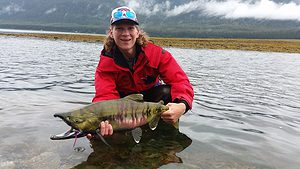
There are some necessary details to pay attention to when you’re going to fish with beads! Color and size are vital.
Best Bead Size To Use
The most common beads are typically between 6mm and 14mm.
For sockeye salmon, use a 6mm bead.
If you’re fishing below pike and coho, an 8mm bead is great.
Use a larger bead, such as an 8 or 10mm, for chum and king salmon.
If you’re fishing in slower water, fish with smaller beads, as these will follow the current better. Fish have more time to see whether or not the bead is real in slower water. If you’re fishing fast water, you have more freedom to use larger beads. Larger beads can also mean larger trout!
Best Bead Color To Use
Orange or red are the best bead colors to use. As the spawning season nears the end, you will want to use washed-out dead egg colors, such as mottled, pearl, and lighter colors.
When eggs are initially laid, they look orange and oily. It becomes more light pink or peach as it sits in the water. Always begin fishing with a bead the same color as a live egg for the best possible results, then change to less live-looking colors.
If you’re wondering where to purchase beads, it’s quite easy! Any fly shop will sell beads, but you can also find massive packs online.
Tip: There are four main types of beads used in fly fishing: standard beads, mottled beads, blood dot beads, and glo beads.
Beads Attached To Flies
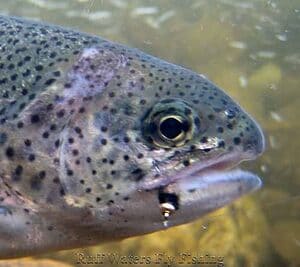
Certain flies in your fly box have a bead as part of the fly. It is right at the line to hook attachment. This is called a “bead head” and is certainly one of the most common ways of presenting wet flies (nymphs).
Typically, the weight of a brass or tungsten bead helps keep the fly very close to the bottom of the river bed, which is the prime location for trout to be when feeding. The bright-colored beads, usually gold, attract not only trout but also are very effective for bass or panfish.
Due to the color and the flash of the bead, your fly stands out more, and fish will home in on the best-looking fly!
2. Beads Used For Sea Fishing
Colored beads are commonly used in sea fishing everywhere in the world. There are several purposes; in most cases, the beads are threaded onto the fishing line itself.
Small size beads are added to rigs to trap swivels in place, and larger beads are used to protect pre-tied knots in pulley rigs and running ledger rigs.
Very often anglers will attach sequins onto the line next to the beads, this creates a line of beads or sequins to attract fish to the baited hooks. This is a very common and effective method for catching fish in the flatfish group, especially flounders.
There are five main types of beads used in sea fishing scenarios:
Rig Beads
Rig beads are a simple part of a rig and basically only used for trapping swivels.. These are small beads around 3mm in diameter and can be round, oval, or egg-shaped.
Many anglers differentiate their rig set-ups by using different colors to make them easy to identify. These types of beads are also known as microbeads.
6mm / 8mm Beads
6mm or 8mm beads protect knots when used in a pulley rig or in running ledger sea fishing rigs. These rigs are popular for catching large ling, congar eel, and skate. Coupled with sequins in a group, the 8mm beads are perfect for large flatfish due to their attraction when strung together.
The 6 and 8mm beads are the most common sizes sea anglers use on their rigs. They are often used in colors such as luminous green, orange, red, or yellow to make them stand out in the murky seawater.
Slip Rig
The color and type of bead in a slip rig do not matter as the purpose of the bead is just as a stop mechanism.
Plastic beads for a slip rig are used between the knot and sinker. The bead hole is bigger than the line diameter, which pushes it against the knot, in this way the knot and line do not get damaged or weakened. The sinker will then stop at the bead because its outside diameter is larger than the hole inside the sinker.
Slip Bobber Rig
A bobber (float) rig works in the same way as the slip rig, except that a bobber is stopped/trapped by the bead at the depth that the angler has set. This is extremely useful when fishing at depths of 15 ft or more where your rod is too short to take this line depth. It is also called a slider rig.
This method is often used in harbors or slack deep water to fish on the bottom with a bobber set up rather than a running ledger rig.
Breakaway Beads
Breakaway beads only serve one purpose: to “clip” and hold the retaining wire legs on a lead weight when fishing on a sandy sea bottom. When the angler retrieves his rig, the wire legs will fold back via the beads to retrieve the rig from the sand.
There are typically four beads used, one on each wire leg.
3. Beads For Lure Fishing
The same beads that can be purchased and used in fly fishing are also used by lure anglers to catch predator fish such as zander, pike, and walleye. Bass anglers commonly use them for spinners and lures.
The main differences are the colors and sizes that are used. In lure fishing we are not replicating fish eggs, the color is purely an attractant to imitate a fish or natural water animal such as a frog. There are many different options and colors to choose from, depending on your personal knowledge—some anglers like to rig up their own cocktail of colors as a DIY rig.
The beads do not need to be round and are sometimes used as stacked beads, where they are a string of beads of different sizes joined together. This makes the customization of the lure unlimited!
Final Thoughts
Colored beads are widespread in the angling circle. From replicating an actual fish egg or imitating a small fish or just simply as an aid to make rigs and methods work better – the uses are pretty endless!
I hope this article helped explain all the details of beads and their uses in fishing. You can learn more about a wide range of fishing baits, including how to fish a chatterbait, and tips on using a jerkbait.
- Wading Belt Essentials: Ensuring Safer Fishing - January 9, 2024
- Fishing For Catfish (Top Tips, Bait, & Gear To Catch The Big 3) - October 20, 2022
- Fishing Line Strength Vs. Diameter Chart: Why Is It Important? - October 12, 2022

